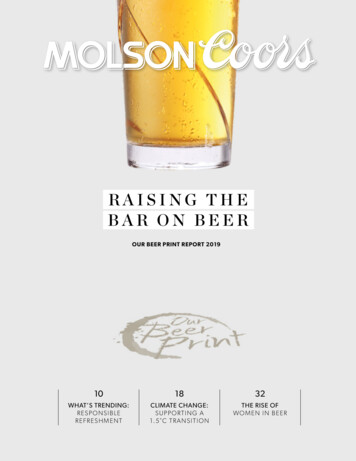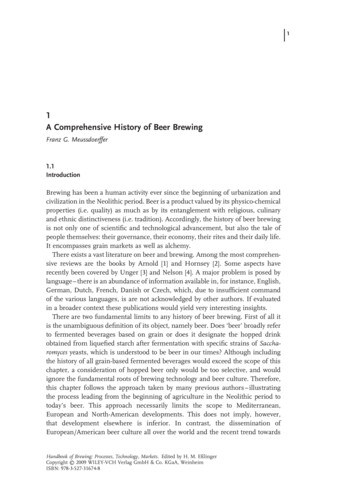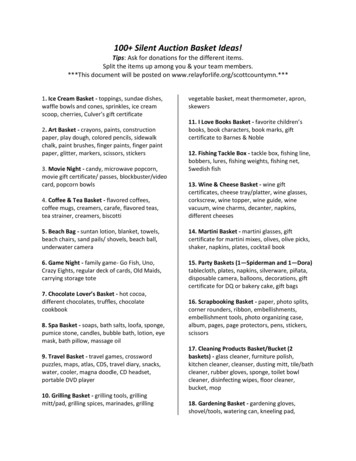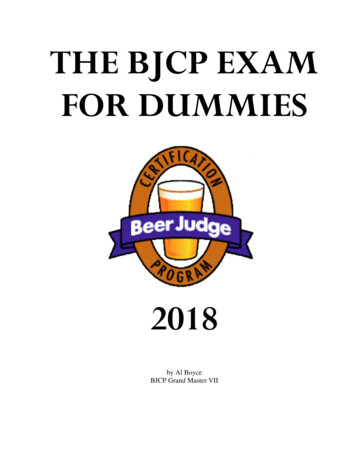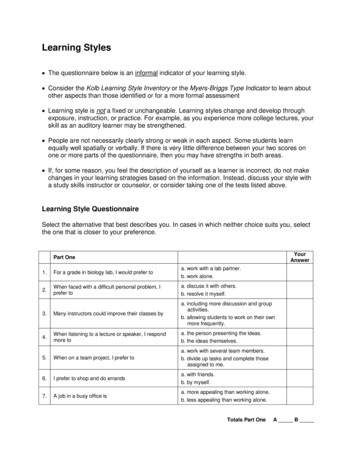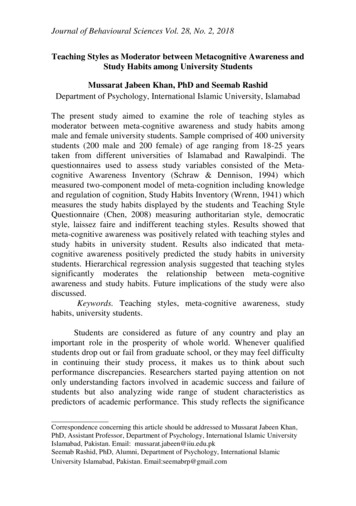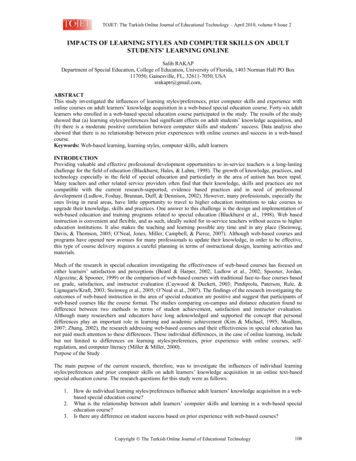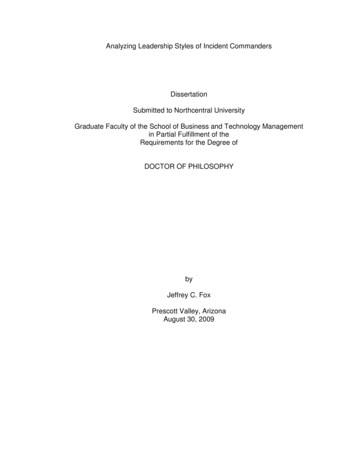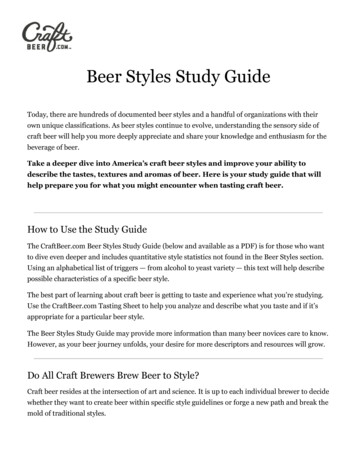
Transcription
Beer Styles Study GuideToday, there are hundreds of documented beer styles and a handful of organizations with theirown unique classifications. As beer styles continue to evolve, understanding the sensory side ofcraft beer will help you more deeply appreciate and share your knowledge and enthusiasm for thebeverage of beer.Take a deeper dive into America’s craft beer styles and improve your ability todescribe the tastes, textures and aromas of beer. Here is your study guide that willhelp prepare you for what you might encounter when tasting craft beer.How to Use the Study GuideThe CraftBeer.com Beer Styles Study Guide (below and available as a PDF) is for those who wantto dive even deeper and includes quantitative style statistics not found in the Beer Styles section.Using an alphabetical list of triggers — from alcohol to yeast variety — this text will help describepossible characteristics of a specific beer style.The best part of learning about craft beer is getting to taste and experience what you’re studying.Use the CraftBeer.com Tasting Sheet to help you analyze and describe what you taste and if it’sappropriate for a particular beer style.The Beer Styles Study Guide may provide more information than many beer novices care to know.However, as your beer journey unfolds, your desire for more descriptors and resources will grow.Do All Craft Brewers Brew Beer to Style?Craft beer resides at the intersection of art and science. It is up to each individual brewer to decidewhether they want to create beer within specific style guidelines or forge a new path and break themold of traditional styles.
Because so many craft brewers brew outside style guidelines, it is impossible to make a list thatfully represents the spectrum of beers being created today. CraftBeer.com Beer Styles includemany common styles being made in the U.S. today, but is not exhaustive.Common U.S. Beer StylesCraft brewers use a wide variety of ingredients to achieve the aroma, body, flavor and finish theydesire in their beer. They often take classic, old-world styles from great brewing countries likeEngland, Germany and Belgium and add their own twists by modifying the amount or type ofingredients or the brewing processes. Due to the popularity of craft beer in America, there arenow multiple beer styles uniquely credited to the U.S.Due to the constant experimentation and exploration by today’s U.S. brewers, new beer styles areconstantly evolving. That makes it difficult, if not impossible, to fully document all types of beerbeing made at any given time. Another factor is that new beer styles usually become establishedby developing a track record of multiple breweries making the same type of beer over years andyears. In other words, it takes time before any trendy new type of beer is deemed a recognizedbeer style.To create this study guide, we looked at the world beer styles recognized by the BrewersAssociation (publishers of CraftBeer.com) and narrowed that list down to 79 styles in 15 stylefamilies. Descriptive terms are always listed from least to most intense.Overview of the Study GuideExplanation of Quantitative Style StatisticsOriginal Gravity (OG): The specific gravity of wort (unfermented beer) beforefermentation. A measure of the total amount of solids that are dissolved in the wort, itcompares the density of the wort to the density of water, which is conventionally given as1.000 at 60 Fahrenheit.Final Gravity (FG): The specific gravity of a beer as measured when fermentation iscomplete (when all desired fermentable sugars have been converted to alcohol and carbondioxide gas). When fermentation has occurred, this number is always less than OriginalGravity.Alcohol By Volume (ABV): A measurement of the alcohol content in terms of thepercentage volume of alcohol per volume of beer. Caution: This measurement is alwayshigher than Alcohol by Weight (not included in this guide). To calculate the approximatevolumetric alcohol content, subtract FG from OG and divide by 0.0075.Example: OG 1.050, FG 1.012 ABV (1.050 – 1.012) / 0.0075 ABV 0.038 / 0.0075ABV 5.067 ABV 5% (approximately)
International Bitterness Units (IBUs): 1 bitterness unit 1 milligram of isomerized(exposed to heat) hop alpha acids in one liter of beer. Can range from 0 (lowest—nobitterness) to above 100 IBUs. Usually the general population cannot perceive bitternessabove or below a specific range of IBUs (said to be below 8 and above 80 IBUs by somesources).Bitterness Ratio (BU:GU): A comparison of IBUs (Bitterness Units) to sugars (GravityUnits) in a beer. .5 is perceived as balanced, less than .5 is perceived as sweeter and over .5is perceived as more bitter. Formula: Divide IBU by the last two digits of Original Gravity(remove the 1.0) to give relative bitterness. Note: Carbonation also balances beer’sbitterness, but is not factored in this equation. This is a concept from Ray Daniels, creator ofthe Cicerone Certification Program.Example: pale ale with 37 IBUs and an OG of 1.052 is 37/52 0.71 BU:GUStandard Reference Method (SRM): Provides a numerical range representing the colorof a beer. The common range is 2-50. The higher the SRM, the darker the beer. SRMrepresents the absorption of specific wavelengths of light. It provides an analytical methodthat brewers use to measure and quantify the color of a beer. The SRM concept wasoriginally published by the American Society of Brewing Chemists.Examples: Very Light (1-1.5), Straw (2-3 SRM), Pale (4), Gold (5-6), Light Amber (7),Amber (8), Medium Amber (9), Copper/Garnet (10-12), Light Brown (13-15),Brown/Reddish Brown/Chestnut Brown (16-17), Dark Brown (18-24), Very Dark (25-39),Black (40 )Volumes of CO2 (v/v): Volumes of CO2 commonly vary from 1-3 v/v (volumes ofdissolved gas per volume of liquid) with 2.2-2.7 volumes being the most common in the U.S.market. Beer’s carbonation comes from carbon dioxide gas, which is a naturally occurringbyproduct created during fermentation by yeast and a variety of microorganisms. Theamount of carbonation is expressed in terms of “volumes” of CO2. A volume is the space theCO2 gas would occupy at standard temperature and pressure, compared to the volume ofbeer in which it’s dissolved. So one keg of beer at 2.5 volumes of CO2 contains enough gas tofill 2.5 kegs with CO2.Apparent Attenuation (AA): A simple measure of the extent of fermentation wort hasundergone in the process of becoming beer, Apparent Attenuation reflects the amount ofmalt sugar that is converted to ethanol during fermentation. The result is expressed as apercentage and equals 65% to 80% for most beers. Or said more simply: Above 80% is veryhigh attenuation with little residual sugar. Below 60% is low attenuation with more residualsugar remaining. Formula: AA [(OG-FG) / (OG-1)] x 100
Example: OG 1.080, FG 1.020 AA [(1.080 – 1.020) / (1.080 – 1)] x 100 AA (0.060 / 0.080) x 100 AA 0.75 x 100 AA 75%Commercial Examples: List some U.S. brewery produced examples of this style.The A-Z of Beer StylesUse this alphabetical list of triggers as a guide to help you when describing possiblecharacteristics of a specific beer style.AlcoholRanges: not detectable, mild, noticeable, harshA synonym for ethyl alcohol or ethanol, the colorless primary alcohol component of beer.Alcohol ranges for beer vary from less than 3.2% to greater than 14% ABV. Sensed in aroma,flavor and palate of beerFusel alcohol can also exist in beerBrewing and Conditioning ProcessBrewers use a wide variety of techniques to modify the brewing process. Some of thevariables they play with might include variable mashing, steeping, unique fermentationtemperatures, multiple yeast additions, barrel aging and blending, dry hopping and bottleconditioned.Carbonation (CO2): VisualRanges: none, slow, medium, fast rising bubblesCarbonation is a main ingredient in beer. It lends body or weight on the tongue andstimulates the trigeminal nerves, which sense temperature, texture and pain in the face.Carbonation can be detected as an aroma (carbonic acid). It also affects appearance and iswhat creates the collar of foam common to most beer styles.Carbonation can be naturally occurring (produced by yeast during fermentation) or addedto beer under pressure. Nitrogen can also be added to beer, providing smaller bubbles and asofter mouthfeel compared to CO2.Clarity: The degree to which solids in suspension are absent in beer; different from color andbrightness.Ranges: brilliant, clear, slight haze, hazy, opaqueSolids can include unfermented sugars, proteins, yeast sediments and more.The degree to which solids are present in solution is referred to as turbidity.Color (SRM): See SRM under Quantitative above.
Country of Origin: The country from which a style originatesFood Pairing: Cheese, Entree, DessertGlass: The recommended glassware for each beer style.Hop IngredientsFlavor and aroma ranges: citrus, tropical, fruity, floral, herbal, onion-garlic, sweaty, spicy,woody, green, pine, spruce, resinousBitterness ranges: restrained, moderate, aggressive, harshHops deliver resins and essential oils that influence beer’s aroma, flavor, bitterness, headretention, astringency, and perceived sweetness. They also increase beer’s stability and shelflife.Brewers today use well over 100 different varieties of hops worldwide. Hops grown in theU.S. contribute an estimated 30 percent to the global supply.Malt IngredientsFlavor and aroma ranges: bread flour, grainy, biscuit, bready, toast, caramel, prune-like,roast, chocolate, coffee, smoky, acridMalt has been called the soul of beer. It is the main fermentable ingredient, providing thesugars that yeast use to create alcohol and carbonation.Malt is converted barley or other grains that have been steeped, germinated, heated, kilned(or roasted in a drum), cooled, dried and then rested.A wide variety of barley and other malts are used to make beer, including pale malt (pilsnerand pale two-row), higher temperature kilned malt (Munich and Vienna), roasted/specialtymalt (chocolate and black) and unmalted barley. Wheat malt is commonly used as well.Malt provides fermentable and non-fermentable sugars and proteins that influence beer’saroma, alcohol, body, color, flavor and head retention.Other IngredientsAdjuncts are ingredients that have typically not been malted, but are a source of fermentablesugars.Common adjuncts include: candy sugar, honey, molasses, refined sugar, treacle, maplesyrupUnmalted starchy adjuncts: oats, rye, wheat, corn/maize, riceNote: Many of these grains can be malted to create unique flavors compared to theirunmalted counterparts.Other: fruit, herbs, roasted (unmalted) barley or wheat, spices, woodOxidative/Aged Qualities
Can come from hops, malt or yeast. Only listed where appropriate for the specific style.Aroma/Flavor: almond, blackcurrant, E-2-nonenal (papery/cardboard), honey, metallic,sherry, sweat socks, othersColor: Beer darkens over time due to oxygen ingress.PalatePalate refers to the non-taste sensations felt on the mouth and tongue when tasting a beer.The palate of a beer can be sensed as:AstringencyRanges: low, medium(-), medium, medium( ), highBodyRanges: drying, soft, mouth-coating, stickyPalate CarbonationRanges: low, medium, highLength/FinishRanges: short (less than 15 seconds), medium (up to 60 seconds), long (more than 60seconds)Serving TemperatureStorage of draught beer should remain at 38 F to retain the level of carbonation createdduring fermentation.The service temperature of beer has an impact on the sensory aspect of a beer.In general, a beer will exhibit an increase in perceived aromas and flavors if served warmerthan a beer that is served at a cooler temperature.A general rule of thumb calls for ales to be served at a warmer temperature (45-55 F) thantheir lager counterparts (40-45 F).Water TypeCommon taste descriptors: chalk, flint, sulfur and moreBeer is mostly water, which makes water quite an important ingredient. Some brewers maketheir beer without altering the chemistry of their water sources. Many do modify the waterto make it most suitable to deliver the beer characteristics they hope to highlight. It providesminerals and ions that add various qualities to beer.Common minerals: carbonate, calcium, magnesium, sulfateYeast, Microorganisms and Fermentation ByproductsYeast eats sugars from malted barley and other fermentables, producing carbonation,alcohol and aromatic compounds. The flavor of yeast differs based on yeast strain,temperature, time exposed to the beer, oxygen and other variables.
Types of Yeast:Ale: Saccharomyces Cerevisiae (ester driven). Commonly referred to as top fermentingyeast, it most often ferments at warmer temperatures (60-70F).Lager: Saccharomyces Pastorianus (often lends sulfuric compounds). Commonlyreferred to as bottom fermenting yeast, it most often ferments at cooler temperatures(45-55F).Weizen Yeast: Common to some German-style wheat beers and is considered an aleyeast.Brettanomyces: wild yeast with flavors like barnyard, tropical fruit, and more.Microorganisms: (bacteria) Acetobacter (produces acetic acid),Lactobacillus/Pediococcus (produce lactic acid), othersByproducts of FermentationFor a robust spreadsheet on many byproducts or agents in beer see Flavor Components inBeer (PDF)Common byproducts of yeast fermentation:Esters:Aromas (volatiles): apple, apricot, banana, blackcurrant, cherry, fig, grapefruit,kiwi, peach, pear, pineapple, plum, raisin, raspberry, strawberry, othersCommon esters include:Isoamyl acetate (common from weizen ale yeast): banana, pearEthyl acetate: nail polish remover, solventEthyl hexanoate: red apple, fennelPhenolsCommon phenols include:4-vinyl guaiacol: clove, cinnamon, vanillaChlorophenols: antiseptic, mouthwashSyringol: smoky, campfireTannins/Polyphenols: velvet, astringent, sandpaperOther fermentation byproductsCommon byproducts include (when acceptable to style):4-ethyl-phenol: barnyard, mice4-ethyl-guaiacol: smoked meat, clove3-methyl-2-butene-1-thiol: lightstruck2,3-butanedione (Diacetyl)AcetaldehydeDimethyl sulphide (DMS)Hydrogen sulphide
What is Craft Beer? What is a Craft Brewer?Today is the best time in U.S. history to be a beer lover. The average American lives within 10miles of a brewery, and the U.S. has more beer styles and brands to choose from than any otherbeer market in the world.The definition of “craft beer” is difficult, as it means many different things to many different beerlovers. Thus, craft beer is not defined by CraftBeer.com. However, our parent organization, theBrewers Association, does define what it means to be an American craft brewer: A U.S. craftbrewer is a smaller producer (making less than six million barrels of beer a year) and isindependently owned. This definition allows the Brewers Association to provide statistics on thegrowing craft brewery community, which accounts for 98 percent of America’s 6,300 breweries.Visit BrewersAssociation.org for the complete craft brewer definition and details on the craft beerindustry market segments: brewpubs, microbreweries and regional craft breweries.Why Craft Beer?Craft beer is enjoyed during everyday celebrations and is viewed by many as one of life’s specialpleasures. Each glass displays the creativity and passion of its maker and the complexity of itsingredients. Craft beer is treasured by millions who see it as not merely a fermented beverage, butsomething to be shared, revered and enjoyed in moderation (see Savor the Flavor).In the food arts world, craft beer is a versatile beverage that not only enhances food when expertlypaired with a dish, but is also often brought into the kitchen as a cooking ingredient. Because ofthis, you will see suggested food pairings for each style in this guide. If you would like to geek outeven further on beer and food pairing, check out CraftBeer.com’s Beer & Food Course (a freedownload).
Table of ContentsPale Ale trong Ale cotti h- t le Ale American Amber AleAmerican Barley WineScotch Ale/Wee HeavyAmerican Pale AleAmerican Imperial Red AleScottish-Style AleBlonde AleBritish-Style Barley Wine AleEnglish-Style BitterEnglish-Style Old AleEnglish-Style Pale Ale (ESB)Dark Lager elgian t le Wild/ our eer American BrettAmerican SourBelgian-Style Blonde AleBelgian-Style FlandersAmerican Amber LagerBelgian-Style DubbelBelgian-Style Fruit LambicGerman-Style DunkelBelgian-Style Golden Strong AleBelgian-Style Lambic/GueuzeGerman-Style Marzen / OktoberfestBelgian-Style Pale AleContemporary GoseGerman-Style SchwarzbierBelgian-Style QuadrupelVienna-Style LagerBelgian-Style SaisonPil ener and Pale Lager Belgian-Style TripelAmerican Lager rown Ale Bohemian-Style PilsenerAmerican Brown AleH rid eer English-Style Brown AleAmerican Cream AleGerman-Style HellesEnglish-Style MildFrench-Style Biere de GardeGerman-Style PilsnerIndia Pale Ale California CommonEuropean-Style ExportGerman-Style Brown/Altbier pecialt eer American IPAGerman-Style KolschAmerican Black AleEnglish-Style IPAIrish-Style Red BeerBarrel-Aged BeerImperial India Pale AleNew England IPAWheat eer Porter Chocolate BeerCoffee BeerAmerican Imperial PorterFruit and Field BeerBaltic-Style PorterGluten-Free BeerAmerican-Style Wheat Wine AleEnglish-Style Brown PorterHerb and Spice BeerAmerican WheatRobust PorterHoney BeerBelgian-Style WitbierSmoke PorterPumpkin BeerBerliner-Style WeisseRye BeerGerman-Style Dunkelweizen tout German-Style HefeweizenAmerican Imperial StoutSmoke BeerAmerican StoutSpecialty BeerEnglish-Style Oatmeal StoutEnglish-Style Sweet Stout (Milk Stout)Irish-Style Dry Stout ock German-Style BockGerman-Style DoppelbockGerman-Style MaibockGerman-Style WeizenbockSession Beer
American Amber Ale t le Famil : Pale Ale Like most amber beers, American amber ale is named after the golden to amber color this American version of English pale aleexhibits. The color is derived from the use of caramel and crystal malt additions, which are roasted to provide amber beers with thecolor, body and flavor many beer fans have come to appreciate. Falling under the ale beer type, amber ales ferment at warmertemperatures for what is typically a much shorter amount of time than lager style beers.American Amber AleThe American amber ale is one of the most widely enjoyed styles throughout the United States and serves as a cornerstone style ofthe American craft brewing revolution. American ambers are darker in color than their pale ale cousins, the presence of carameland crystal malts lending a toasted, toffee flavor, along with the perception of a fuller body when compared to beers without suchmalts. Amber beer showcases a medium-high to high malt character with medium to low caramel character derived from the use ofroasted crystal malts. The American amber is characterized by American-variety hops, which lend the amber ale notes of citrus,fruit and pine to balance the sweetness of the malt.As with many amber beer types, American amber ale is a highly versatile companion to American cuisine, particularly foods thatare grilled or barbecued, as roasted malts complement seared, charred and caramelized proteins making this ale beer type aperennial favorite at backyard cookouts.Amber Ale Beer Near YouThe popularity of the American amber ale makes the style one of the easier amber beers to seek out at small and independent craftbreweries or find in a local craft-centric retailer. Across the country, you can discover countless variations of the amber ale. Useour “Find a Brewery” map to help you discover the amber ale beers at a new brewery near you.If you enjoy the website and are interested in a convenient way to learn about amber beer, sign up to have our newsletter delivereddirectly to your inbox.Quantitative t le tati tic OGFGABVIBUBU:GUSRMCO2 VolumesApparent Attenuation1.048 - 1.0581.012 - 1.0184.4% - 6.1%25 - 450.62 - 0.7811 - 182 - 2.569 - 75U. . Commercial xample HopBack Amber Troegs Brewing Co.Boont Amber Anderson Valley Brewing Co.Red Seal North Coast Brewing Co. t le A-ZAlcoholCarbonation (Visual)ClarityColorCountry of OriginMild to NoticeableMedium to Fast Rising BubblesClear to Slight HazeCopper to Reddish BrownUnited StatesFood Pairing Cheese Medium CheddarEntrée BarbecueDessert Banana Pound Cake
GlassHop Aroma/FlavorCommon Hop IngredientsMalt Aroma/FlavorCommon Malt IngredientsPalate BodyPalate CarbonationPalate Length/FinishServing TemperatureWater TypeTulipCitrus-like character is acceptableHorizon, Cascade, CentennialCaramelEnglish Pale Ale or American Two-Row, Crystal, VictoryMouth-CoatingMedium to HighShort to Medium45-55 FVariesYea tType AlePhenols Not common to styleEsters There may below levels of fruity-ester flavorSource: CraftBeer.com
American Pale Ale t le Famil : Pale Ale Like many others that have become known as classic American beers, the American pale ale can trace its roots to beer styles fromabroad. The American pale ale beer was inspired by the English pale ale, replacing its English counterpart’s earthy, herbal hopswith generous additions of boldly citrus and pine-like American varieties. As one of the most popular American beer styles, pale alebeer is not hard to track down, but the various takes on this iconic style by just as many American craft brewers makes itimpossible to jam everything there is to know about American pale ale beer on one page, but we’ll do our best.American Pale Ale BeersCharacterized by floral, fruity, citrus-like, piney, resinous American hops, the American pale ale is a medium-bodied beer with lowto medium caramel, and carries with it a toasted maltiness. American pale ale is one of the most food-friendly styles to enjoy, sincethe pale ale works wonderfully with lighter fare such as salads and chicken, but can still stand up to a hearty bowl of chili; a varietyof different cheeses, including cheddar; seafood, like steamed clams or fish, and even desserts. The American pale ale’s affinity tofood can be attributed to the simplicity of its ingredients, which include toasty pale malt, a clean fermenting ale beer yeast, and thecounterbalance of American hops to help tease out the flavor or cleanse the palate, preparing you for another bite.Pale Ale Beer in AmericaWhile pale ale beer has definitively English roots, many credit the American take on the style to the advent of Sierra Nevada PaleAle, which employs the use of American Cascade hops and a clean fermenting ale yeast that has become synonymous with today’sWest Coast style craft beers. Currently, pale ales offer beer fans a balance between malt and hops, which make pale ales one of themost enjoyed and approachable beer styles available.American Pale AleAmerican pale ale beer remains a staple of the American beer world because it continues to evolve. With each passing day,independent breweries across the country are reimagining the classic pale ale by experimenting with local ingredients to craftflavor profiles that push the boundaries of beer. If you’d like to further explore the world of pale ales and learn more aboutAmerican pale ale beers, continue to explore our site. Expand your American pale ale knowledge base by responsibly trying beersfirst hand, and track down craft breweries using our brewery map.Quantitative t le tati tic OGFGABVIBUBU:GUSRMCO2 VolumesApparent Attenuation1.044 - 1.0501.008 - 1.0144.4% - 5.4%30 - 500.68 - 1.006 - 142 - 2.572 - 82U. . Commercial xample Stick's Pale Ale Bootstrap Brewing Co.Pale Ale Sierra NevadaMirror Pond Deschutes Brewery t le A-ZAlcoholCarbonation (Visual)ClarityBrewing/Conditioning ProcessColorCountry of OriginNot Detectable to MildMedium to Fast Rising BubblesClear to Slight HazeDry-hopping or late hop additions to the kettle are commonDeep Golden to Copper or Light BrownUnited States
Food Pairing Cheese Mild or Medium CheddarEntrée Roasted or Grilled MeatsDessert Apple PieGlass TulipHop Aroma/Flavor Hop aroma and flavor are medium to medium-high, exhibiting fruity, floral, andcitrus-like American-variety hop aromas. Hop bitterness is medium to mediumhighCommon Hop Ingredients Horizon, Cascade, CentennialMalt Aroma/Flavor Biscuit, Bready, CaramelCommon Malt Ingredients Pale, Caramel, MunichPalate Body SoftPalate Carbonation Medium to HighPalate Length/Finish Short to MediumServing Temperature 45-55 FWater Type Sulfite content may vary, but carbonate content should be relatively lowYea tType AlePhenols Not common to styleEsters Citrus, Tropical Fruit, PineSource: CraftBeer.com
Blonde Ale t le Famil : Pale Ale One of the most approachable styles, a golden or blonde ale is an easy-drinking beer that is visually appealing and has noparticularly dominating malt or hop characteristics. Rounded and smooth, it is an American classic known for its simplicity.Sometimes referred to as “golden ale.” These beers can have honey, spices and fruit added, and may be fermented with lager or aleyeast.Quantitative t le tati tic OGFGABVIBUBU:GUSRMCO2 VolumesApparent Attenuation1.045 - 1.0541.008 - 1.0164.1% - 5.1%15 - 250.33 - 0.453-72 - 2.571 - 82U. . Commercial xample Summer Love Ale Victory Brewing Co.Twilight Summer Ale Deschutes BreweryKirby Echo Brewing Co. t le A-ZAlcoholCarbonation (Visual)ClarityColorCountry of OriginNot Detectable to MildMedium to Fast Rising BubblesBrilliant to Slight HazeStraw to Light AmberUnited StatesFood Pairing Cheese Pepper JackEntrée Spaghetti and MeatballsDessert Sugar CookiesGlass TulipHop Aroma/Flavor Hop aroma is low to medium-low, present but not dominant. Hop bitterness islow to medium-low.Common Hop Ingredients WilliametteMalt Aroma/Flavor Light malt sweetness is present in the flavor. Bread, toast, biscuit and wheatflavors are common.Common Malt Ingredients American Two-Row, CrystalOther ingredients May include up to 25 percent Malted Wheat and sugar adjuncts.Palate Body SoftPalate Carbonation Medium to HighPalate Length/Finish ShortServing Temperature 45-50 FWater Type VariesYea tType Lager or AlePhenols Not common to style.Esters Fruity esters may be perceived but not predominant.Source: CraftBeer.com
English-Style Bitter t le Famil : Pale Ale The English-style bitter is a very sessionable, lower-alcohol, malt-driven style. Broad style description commonly associated withcask-conditioned beers. The light- to medium-bodied ordinary bitter is gold to copper in color, with a low residual malt sweetness.Hop bitterness is medium.Quantitative t le tati tic OGFGABVIBUBU:GUSRMCO2 VolumesApparent Attenuation1.033 - 1.0381.006 - 1.0123.0% - 4.2%20 - 350.61 - 0.925 - 121 - 1.568 - 82U. . Commercial xample Midsummer Fling Harpoon BreweryPale Ale Rio Blanco Brewing Co.Redfeather Black Raven Brewing Co. t le A-ZAlcoholCarbonation (Visual)ClarityColorCountry of OriginNot Detectable to MildSlow Rising BubblesClear to BrilliantGold to CopperUnited KingdomFood Pairing Cheese Firm English CheesesEntrée Roasted Chicken, Fish and ChipsDessert Oatmeal Raisin Walnut CookiesGlassHop Aroma/FlavorCommon Hop IngredientsMalt Aroma/FlavorCommon Malt IngredientsPalate BodyPalate CarbonationPalate Length/FinishServing TemperatureWater TypeNonic PintHop aroma may be evident at the brewer's discretionKent GoldingsLow to medium residual malt sweetness is presentBritish Pale Ale, Aromatic, Crystal, Special RoastDrying to SoftLowShort50-55 FVariesYea tTypePhenolsEstersFermentation ByproductsAleNot common to styleFruity esters are common.Low-level diacetyl aromas and flavor are acceptableSource: CraftBeer.com
English-Style Pale Ale (ESB) t le Famil : Pale Ale ESB stands for “extra special bitter.” This style is known for its balance and the interplay between malt and hop bitterness. Englishpale ales display earthy, herbal English-variety hop character. Medium to high hop bitterness, flavor and aroma should be evident.The yeast strains used in these beers lend a fruitiness to their aromatics and flavor, referred to as esters. The residual malt anddefining sweetness of this richly flavored, full-bodied bitter is medium to medium-high.Quantitative t le tati tic OGFGABVIBUBU:GUSRMCO2 VolumesApparent Attenuation1.040 - 1.0561.008 - 1.0164.4% - 5.3%20 - 400.50 - 0.715 - 121.5 - 271 - 80U. . Commercial xample 5 Barrel Pale Ale Odell Brewing Co.Royal Scandal Peticolas Brewing Co.Moondog Ale Great Lakes Brewing Co. t le A-ZAlcoholCarbonation (Visual)ClarityColorCountry of OriginMildSlow Rising BubblesClear to BrilliantGold to CopperUnited KingdomFood Pairing Cheese English-Style CheesesEntrée Roasted Chicken, Fish and ChipsDessert Maple Bread PuddingGlass Nonic PintHop Aroma/Flavor Hop flavor is medium to medium-high. Hop bitterness is medium to mediumhighCommon Hop Ingredients Kent GoldingsMalt Aroma/Flavor Residual malt and defining sweetness is medium to medium-highCommon Malt Ingredients British Pale Ale, CrystalOther ingredients Some versions use sugar, corn or wheatPalate Body ModeratePalate Carbonation LowPalate Length/Finish ShortServing Temperature 50-55 FWater Type Some versions use medium to high sulfateYea tType AlePhenols Not common to styleEsters Fruity-ester and very low diacetyl flavors are acceptable, but should beminimized in this form of bitterSource: CraftBeer.com
American Amber Lager t le Famil : Dark Lager A widely available, sessionable craft beer style that showcases both malt and hops. Amber lagers are a medium-bodied lager with atoasty or caramel-like malt character. Hop bitterness can range from very low to medium-high. Brewers may use decoction mashand dry-hopping to achieve advanced flavors.Quantitative t le tati tic OGFGABVIBUBU:GUSRMCO2 VolumesApparent Attenuation1.042 - 1.0561.010 - 1.0184.8% - 5.4%18 - 300.43 - 0.546 - 142.5 approximately68 - 76U. . Commercial xample Sam Adams Boston Lager Boston Beer Co.Lager Brooklyn BreweryLighter Than I Look Figueroa Mountain Brewing t le A-ZAlcoholCarbonation (Visual)ClarityBrewing/Conditioning ProcessColorCountry of OriginMild to NoticeableMedium to Fast Rising BubblesClear to Slight
The CraftBeer.com Beer Styles Study Guide (below and available as a PDF) is for those who want . To create this study guide, we looked at the world beer styles recognized by the Brewers Association (publishers of CraftBeer.com) and narrowed that list down to 79 styles in 15 style families. Descriptive terms are always listed from least to .
